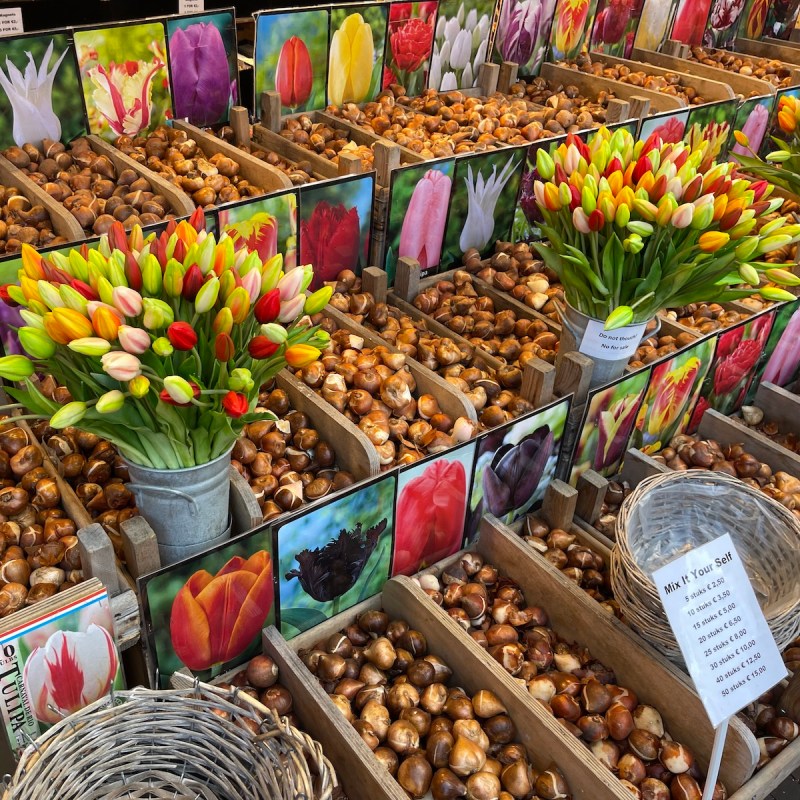
Amsterdam is an exciting city in the Netherlands with so much to see and do that it can be challenging to fit all your sightseeing into one visit. In fact, we went during the fall and enjoyed ourselves so much, we already plan to visit again in spring to catch the famous Holland tulips at their best. We stayed in the Centrum or City Center, as busy and bustling as any in Europe. It’s a very convenient launch pad when visiting Amsterdam. Here are just a few of the amazing things to do in captivating Amsterdam.
Videos by TravelAwaits

1. Van Gogh Museum
For those who enjoy Van Gogh’s art, the Van Gogh Museum is a must-do of top things to see in Amsterdam. The artworks and methods of Vincent Van Gogh come vividly to life with incredible depth. Explore his drawings and letters as well as his masterpieces for an understanding of the ideas behind his process and his world. The room of his self-portraits alone is unforgettable. Irises, Sunflowers, and Bedroom In Arles are just some of the many highlights. Located in Museumplein, the museum is next to the Moco Museum, a great place to see modern, contemporary, and street art from Warhol, Banksy, Basquiat, Haring, and others.
2. Anne Frank House
An important historical landmark in the Netherlands is the Anne Frank House. The memoir Diary of a Young Girl recounts the days Anne Frank and her family spent hiding from the Nazis as they swept through Europe in World War II. The original red-checked diary that the Jewish little girl received on her 13th birthday, just weeks before going into hiding, is on display along with her rewritten version. Also on view are notebooks containing her favorite quotes and short stories she had written. There is much to absorb in the museum and annex, along with the spirit of a brave young girl who recorded her thoughts during one of the most terrifying periods of human history.

3. Amsterdam Canals
One of Amsterdam’s most beautiful features is its iconic 17th-century canal ring, named to the UNESCO World Heritage list in 2010. Each Amsterdam canal is distinctive with its own personality, name, and identity. Beautiful canal houses line them, some of the best examples in the Gouden Bocht (Golden Curve) section. And the Singel canal, which served as a moat around the city before the 16th century, now is the city’s innermost canal.
Canal cruises are available to get a perspective from the water with views of the many lovely bridges. For an inside view of the unique houseboats that line the canals, check out the Woonbootmuseum. For a fun break, stop and refresh at one of the many cafés with a view. Experience Holland like the Dutch with a bike tour or enjoy a guided tour or walking tour to get all the historical and cultural information of the area.

4. De Wallen — The Red Light District
While Holland is famous for tulips and windmills, its capital city is equally famous for De Wallen, Amsterdam’s Red Light District, one of three prostitution areas in a city where it is legal. A singular expression of liberal Dutch culture, the area includes window brothels with sex workers visibly presenting themselves to prospective customers. Interspersed are lovely private homes, porn theaters, and daycare facilities.
For an inside view, check out Red Light Secrets, a former brothel turned into a museum of prostitution. Admission includes a booklet of history and an audio guide with the tell-all stories of Inga, the city’s most notable lady of the evening. Visitors can sit in a window and try out their flirting skills with the many passersby. De Wallen also has lots of coffee shops that sell cannabis products, also legal in Amsterdam, (the Cannabis College is here too). A police-enforced code of conduct makes it a lively and safe area for unique nightlife in the city.

5. Rijksmuseum
The Rijksmuseum is one of the most admired art museums in Europe. With over 30 art galleries devoted to the Dutch Golden Age, the museum is a source of pride as well as inspiration. Some of the world’s most famous paintings are housed here including masterpieces by Frans Hals, Jan Steen, Rembrandt, and Vermeer.
Undoubtedly the biggest attraction is The Night Watch, which is fully on view in a glass chamber under Operation Night Watch, in which research on Rembrandt’s masterpiece continues. Nearby in this Museumplein neighborhood is the Stedelijk Museum for modern and contemporary art and design. For a little fresh air, about a 15-minute walk leads to beautiful Vondelpark, Amsterdam’s answer to Central Park.

6. Jordaan
One of our favorite parts of Amsterdam is the Jordaan neighborhood. A working-class area fallen into 19th-century decay, the area was reborn when students, artists, and young professionals moved into the area and brought it new life. This is the perfect place to take a food tour or just to wander leisurely and enjoy. There are lots of restaurants and cafés, especially catering to breakfast and brunch lovers. Enjoy a Bloody Mary with your favorite early-day meal or just sit on a patio with a hot cuppa and watch the city come to life.
On Saturdays, the Lindengracht Market offers over 230 stalls with everything from fresh fish and produce to Dutch specialties, clothing, leather goods, and more. Take a break with the fabulous Dutch apple pie at Winkel 43 and splurge with the whipped cream. If you’re there on a Monday or Saturday, finish off with a stroll through the incredible Noordermarket flea market, which has been operating since 1623.

7. Rijsttafel — Indonesian Rice Table
For a unique dining experience, save up your appetite and try a rijsttafel, which is dutch for “rice table.” This fun Indonesian meal was invented by Dutch plantation owners in Indonesia who wanted to enjoy a broad array of dishes at the same time. The meal became a festive banquet used to celebrate the multiple cultures of Indonesia.
It has come to incorporate many different dishes served in small portions ranging from satays, egg rolls, sambals, fruit, pickles, vegetables, meat, fish, and curries laid out enticingly along a table. Accompanying rice is an integral part of the elaborate display. After the independence of Indonesia from Dutch colonialism, rijsttafel is rarely seen in Indonesia but thrives in the Netherlands. We had a wonderful time with ours at Kartika restaurant but there are many to choose from all over the city.
8. Bloemenmarkt
Established in 1862, the Bloemenmarkt is the only floating flower market in the world. A colorful spot that is fun to stroll along, the market contains flower stalls that stand on houseboats, reminiscent of when the flower sellers made deliveries by boat. Fresh flowers such as tulips, geraniums, narcissus, and others can be available in stems, bouquets, or bulbs and vary by season. Around the holidays, fresh green Christmas trees are on offer too. For avid gardeners, many of the bulbs are export-ready, so they can be taken home to other countries. The market also offers packets of seeds and plenty of Dutch souvenirs like wooden clogs and tulips, as well as cheese and other treats.

9. De Kattenkabinet
Amsterdam is a dog-loving city, as seen by the many pups going for walks or trotting alongside bicycles with their people. But fear not, cat lovers. There’s a special place in the city just for you! De Kattenkabinet (Cat Cabinet) is a small but charming museum inside a lovely old home that is devoted entirely to those of the feline persuasion. Founded by a wealthy Dutch cat lover to commemorate his own beloved kitty, this fun-filled homage to catdom has a lot of appeal and pretty amazing cat-focused art. Photos of cats with their celebrated owners, sculptures, paintings, books, drawings, posters, and memorabilia honor the feline in all its glory.
There’s a wonderful garden back of the house with posters and benches for relaxing. A little shop by the entrance also offers pussycat items for sale. Several fully-operational felines live on the premises, and when we were there, more than one of them seemed nonplussed by the presence of many adoring fans. Unfortunately, the house, where its owner still lives upstairs, is not yet able to accommodate individuals limited by handicaps.
10. The Nine Streets
De Negen Straatjes or The Nine Streets consists of nine side streets off the Prinsengracht, Keizersgracht, Herengracht, and Singel canals in central Amsterdam which have been marketing themselves as a unique shopping destination since the 1990s. The area is a fun place filled with lots of diverse boutiques and restaurants. The buildings on the streets themselves date back to the 18th century, including more than 140 national and municipal monuments. Vintage goods, quirky art, books, Dutch specialties, and all sorts of unique items can be found in the area. Grab a treat from one of the bakeries or cafés. It’s a fun place to stroll and enjoy the vibe.

11. Albert Cuyp Market
Back around 1904, salesmen gathered to sell their wares to working-class residents. The unorganized space became a hazard, so the city made rules to manage the madness. Over time the wide street offering the Albert Cuyp Market afforded vendors space to set up stalls to sell whatever appealed to the shoppers who increasingly came from other countries. Thus evolved the wonderfully diverse collection where now some 20,000 visitors shop on weekdays with twice as many on Saturdays. 300 stalls sell everything from fresh produce, cheese, fish, and poultry to clothing, personal items, and household goods. Stalls sell prepared global foods as well as Dutch treats like poffertjes (mini pancakes), pickled herring, and crispy potato fries. But our favorite treat was a huge caramel-filled stroopwafel, freshly made, deliciously warm, and gooey.
Amsterdam is a captivating city with many amazing things to see and do. We can’t wait to get back to discover even more of what the Dutch capital has to offer.
